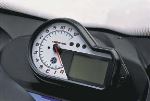 They say that seeing is believing and one of the most important factors to your snowmobile living a long and healthy life revolves around believing it's running safe.
They say that seeing is believing and one of the most important factors to your snowmobile living a long and healthy life revolves around believing it's running safe.
The seeing part of this believing comes from the sled's gauges-something every snowmobile has and an essential part to any sled's performance.
In the early years gauges weren't so well thought out. Does anyone remember the Arctic Cat models of the 80s with the gauges mounted down next to the pull cord? How long did those last before the faceplate was broken from the rope handle smacking it? Fast forward to the stretch from 2003-05 when the "performance" mountain sleds didn't even come with speedometers, just a tach. Whether it was for lightweight reasons or not, it sure made it nice when it came time to sell the machine. With no odometer readings you could just pretend it had really low mileage.
The use of a tachometer allows you to fine tune clutching and diagnose problems. Walk into any dealership and tell them your sled isn't running right. It's almost a 100 percent guarantee the first question the mechanic will ask is, "What's it taching?"
Seems like you can judge the performance of a sled by how many gauges have been mounted on the bars. Along with the factory-installed speedometer you'll see egt monitors, tachometers, water temp gauges, air/fuel ratio gauges and boost gauges. Some of the fastest sleds on the hill have enough gauges to distract you from the large avalanche you should be running from.
A Nice Turn
The evolution of instrumentation and gauges has taken a nice turn as of recent model years. Through the 90s, standard black face needle gauges were the norm. Your basic speedo and tach were placed in the dash for perfect viewing while cruising and sitting. There were also the Yamaha Phazer models that moved the gauges up onto the handlebars so they'd follow you everywhere you turned. The progression into the more dedicated mountain models led to the easier-to-read white face needle gauges. Manufacturers also repositioned the gauges to accommodate the new trend of stand up mountain style riding. As riding styles became more upright and aggressive, so did gauge displays.
Digital readouts have slowly but surely worked their way into our market as well. Digital displays allow just one gauge to show you just about every parameter of your sled you'll ever need toknow about. Water temperature, engine run time, dual trip meters, tachometer, speed are the norm and some even display handwarmer intensity and elevation, all at just the push of a button or flip of a switch.
Today's Arctic Cat models still offer your basic needle style gauges while encasing a digital display as well. Riders can toggle between displays to their preference as the need arises. Ski-Doo Summit models now come equipped with built-in altimeters.
When it comes down to it, instrumentation is a vital component and tuning tool on any sled. Although what information gauges tell us hasn't changed much through the seasons, how that information is presented has improved vastly.
From better positioning to better displays, gauges are still an important factor to keeping a machine running properly.